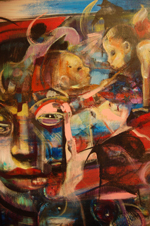 When
Joe Kelley was organizing the current Church
| State exhibit for the
Bucktown Center for the Arts, artist Les Bell asked him: "Is this
going to be a blue show or a red show?" Kelley recalled.
When
Joe Kelley was organizing the current Church
| State exhibit for the
Bucktown Center for the Arts, artist Les Bell asked him: "Is this
going to be a blue show or a red show?" Kelley recalled.
In an interview this week, Kelley said he was hoping to find something in between: "I was hoping it would be a purple show."
It's curious that two arenas that are often best kept separated - art and politics - share the language of color. Blue signifies the Democrats on the electoral map, and red the Republicans. And red used to represent the threat of communism, whose adherents were of course called pinkos.
Yet those color labels reduce complex subjects and issues - even the populations of entire regions - and rob them of nuance.
Kelley knew that most people would view this exhibit as liberal - "I guess it looks lefty," he said - but thinks the show and the topic are richer than that. For one thing, while church-and-state separation is typically a concern of liberals, preserving that division is a conservative position, in the sense that the barrier between church and state is explicitly and clearly articulated in the Constitution.
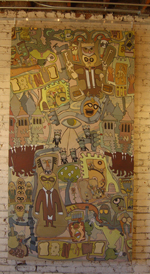 That's
another way of saying Church |
State doesn't have a hard
point of view; it's complicated. "I didn't art-direct the
show," said Kelley, a graphic designer with the Quad-City
Times. "I gave everybody
a broad latitude to express themselves. ... A lot of the artists are
more questioning than stating an opinion."
That's
another way of saying Church |
State doesn't have a hard
point of view; it's complicated. "I didn't art-direct the
show," said Kelley, a graphic designer with the Quad-City
Times. "I gave everybody
a broad latitude to express themselves. ... A lot of the artists are
more questioning than stating an opinion."
Church | State features the work of 14 Quad Cities artists: Paul Algueseva III, Marla Alvarado Neuerburg, Steve Banks, Bell, Cathy Bolkcom, Susan Czechowski, Don Heggen, Kelley, Teresa Mesich, Rachael Mullins, David Murray, Terry Rathje, Patrick Sweeney, and Kathleen Van Hyfte. The show runs through October 31, and a reception is scheduled for Friday evening.
Most citizens agree with the separation of church and state in the abstract - in the way it's described in the First Amendment to the Constitution: "Congress shall make no law respecting an establishment of religion, or prohibiting the free exercise thereof ... ." Yet in practice, church-state is a troublesome issue, whether it's prayer in schools, the Ten Commandments on public property, government funding for faith-based social-service agencies, or gay marriage.
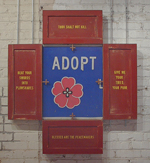 Kelley
said he understands why
people want to impose their faith on public policy. "It really
comes down to one thing: People are trying to insinuate religious
values into government because they see America going down a path
they don't like," he said. "Our society is not as spiritual as
it could be."
Kelley
said he understands why
people want to impose their faith on public policy. "It really
comes down to one thing: People are trying to insinuate religious
values into government because they see America going down a path
they don't like," he said. "Our society is not as spiritual as
it could be."
And he agrees that spirituality is important to the culture; it should simply be left out of government, in his opinion. He said he believes not in a secular society but in a secular government. "If you want to change society," he said, "don't look to government to do it."
Although the exhibit is largely high-minded and serious, Kelley wasn't wed to the church-state exploration at the outset. When he and Terry Rathje (a River Cities' Reader contributor) were talking about ideas, they ranged from "the important to the goofy," Kelley said. One idea for a theme, prompted by a piece by Marla Alvarado Neureburg: women with knives.
Instead, they settled in June 2005 on "religion and politics," which evolved into "religion in politics" and then Church | State. Kelly contacted roughly 20 artists about participating. The vast majority of work in the show was created specifically for the exhibit, he said.
Over the development of Church | State, Kelley would send news articles, Supreme Court decisions, and other church-state-related material to project participants. Some of the artists also sent out information they found. "I became kind of an information clearinghouse," Kelley said.
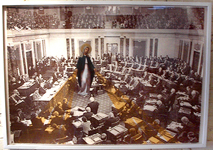 Several
works in the exhibit treat the subject matter literally. Susan
Czechowski's Revelation in the
Senate features a
double-size Virgin Mary in a legislative chamber, for instance.
Several
works in the exhibit treat the subject matter literally. Susan
Czechowski's Revelation in the
Senate features a
double-size Virgin Mary in a legislative chamber, for instance.
Throughout the show, even when familiar symbols and icons are used, the treatments seem ambivalent or ambiguous instead of didactic. Cathy Bolkcom, who is active in Progressive Action for the Common Good, offers a triptych whose three parts form a cross, with the left and right components smaller than the centerpiece. The left panel - titled "Church" - and the right panel - "State" - are separated spatially, yet religious and political symbols intermingle throughout. Jesus waves an American flag, while legislative buildings are topped with crosses. The message seems to be that church and state separation is an unattainable ideal at this point in the country's history.
One of Rathje's contributions is a a troubling construction that suggests an easy moral liquidity, or perhaps merely a cynical view of religious language. The piece in one formulation is pious, with phrases such as "Thou Shalt Not Kill" and "Blessed Are the Peacemakers." But using small handles made of crosses, the panels with those platitudes reveal darker messages underneath: "Capital Punishment Military Assassination" and "Invade/Crusade." At the center of the piece, the word "Adopt" is easily transformed into "Abort."
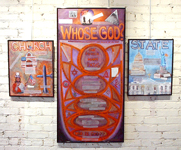 But
many of the show's works are not nearly so bluntly about
church-and-state issues. Bell's Bugs;
Bunny or The Peaceable Kingdom
playfully references Edward Hicks' Peaceable
Kingdom series from the
early 19th Century. While Hicks' paintings were about coexistence -
among people and among animals but also between
people and animals - Bell's painting isn't nearly so direct.
"It's like a puzzle," Kelley said.
But
many of the show's works are not nearly so bluntly about
church-and-state issues. Bell's Bugs;
Bunny or The Peaceable Kingdom
playfully references Edward Hicks' Peaceable
Kingdom series from the
early 19th Century. While Hicks' paintings were about coexistence -
among people and among animals but also between
people and animals - Bell's painting isn't nearly so direct.
"It's like a puzzle," Kelley said.
And given that most people have knee-jerk reactions to church-state issues - they know without thought how they feel about them - perhaps art is an ideal way to get people to think more deeply about this critical debate. "Paintings have to be read, just like a book," Kelley said.
A reception for Church | State will be held on Friday, September 29, from 6 to 9 p.m.










